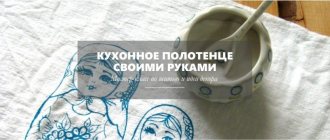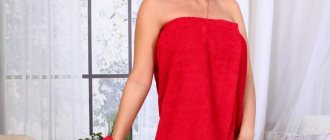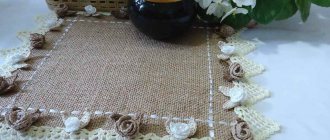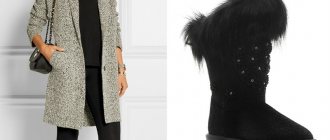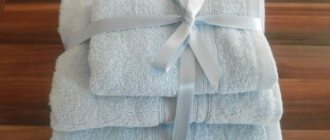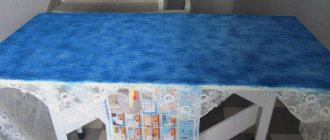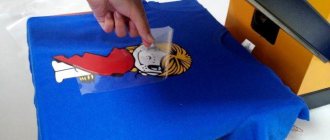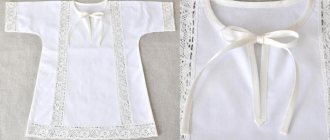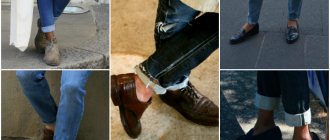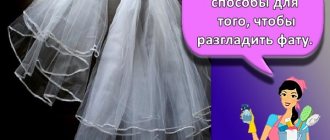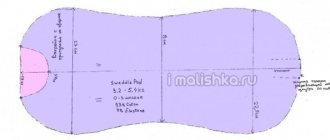A towel for bathing a newborn is not exactly necessary, but very convenient. Some mothers call this accessory irreplaceable. Maybe that’s why often in children’s stores for a seemingly simple terry towel (only a “pocket”-hood is sewn in the corner) prices are almost the same as for a whole terry robe. But inexpensive ones may have some shortcomings: the fabric is not soft enough (and the corner is sticky), the embroidery is itchy, it absorbs poorly, it is small in size...
If you “both want and are itching” to buy a high-quality, expensive corner towel, then I suggest sewing it with your own hands. Below is a detailed master class - instructions with a pattern.
By the way, if you have the opportunity to buy or order goods from Ikea, you can get quite budget towels of good quality there for only 300 rubles. If you really liked towels from other manufacturers, please share your review in the comments.
Even beginners can sew the product in a couple of hours. Why not give such a gift to your baby right today, without delay?
What does a product with a corner look like and how comfortable is it?
A children's towel with a hood is a rectangular or square bath accessory made of soft natural fabric, usually terry with a comfortable cap corner. It combines the advantages of a regular towel and a cap, which is quite difficult to quickly put on a baby’s wet head.
The main purpose of the product is to protect the child from temperature changes by covering him from head to toe.
A towel with a corner has a number of advantages:
- Provides the child with comfort at the final stage of bathing, retaining heat perfectly.
- Convenient to use - just throw the hood over your head and wrap your entire body in one or two movements.
- The corner cap reliably protects the baby's head and ears from hypothermia.
- The pocket does not slip off or crawl into your eyes.
- Hair dries much faster as much of the water is absorbed into the corner.
- There is no need to put a hat, bodysuit, vest or romper on your child right in the bathroom.
- The hood can be decorated with a funny design, and the towel will turn into one of your favorite toys.
- This type of towel is usually perceived with interest by children, even those who do not like long changes of clothes.
- If you purchase or make a fairly large product, then such a towel with a pocket will be useful for a child up to 3 years old.
If several children live in the house, then each of them should have their own towel, preferably in duplicate. Children's textiles should not be used by adults.
Accessories for water treatments with a pocket are so practical that several options for their design have appeared on the market:
- Standard bath towel with corner: suitable for children from the first days of life, when the body is especially vulnerable to the negative effects of drafts and sudden changes in temperature. It is convenient to wrap a baby in it who cannot yet stand on his own legs.
- A towel-poncho with a pocket for the head: an interesting accessory for children over 2 years old, which can easily replace a robe, especially in winter. After drying with a regular towel, the child puts on such a cape to completely dry off.
- A towel with a corner for the beach: it will be useful for both the youngest vacationers and older children, up to 6-9 years old. The hood will help cover your wet head from drafts and scorching sun. The baby's shoulders, which can quickly get burned, will also be protected.
Color and pattern
In the first days and weeks of life, the child sees the world around him poorly and unclearly, so he is not interested in colors and patterns at this time. For the first time, you can buy towels for your baby in muted, pastel colors with minimal prints. This is also justified from a safety point of view. The more saturated the color, the more paint went onto the fabric. Dyes with strong odors can fade and cause allergies.
The color of the baby towel should not be very bright, this may indicate the presence of dye. You should choose a towel without buttons, beads or similar decorations, so as not to injure the baby.
Choose baby towels without bows, beads, buttons or other potentially dangerous decorations for your baby. His skin is so delicate and susceptible to damage that all this jewelry can damage it.
Description
Today, manufacturers have foreseen this need in advance, which has led to the emergence of interesting models. So, first you need to consider the main features.
- Form;
- Material;
- Dimensions.
It is impossible to immediately cover the widest selection of models offered by well-known manufacturers. However, experienced parents have long been accustomed to trusting their own feelings
Because of this, an interesting shape should be considered first. With its help, it was possible to provide maximum warmth and comfort to the child, without which he often begins to get sick and sleep poorly. When the baby is born, you will also need a bumper for the crib and a mattress for the newborn in the crib.
Shape of towels with corner
In fact, the shape of the towels is their main advantage, which has ensured the interest of numerous buyers. When choosing it, manufacturers combined traditional hats and standard blankets
The result was a unique thing that immediately attracted the attention of modern parents. They no longer need to constantly torture the baby by putting on a cap, but his head remains covered
Interestingly, manufacturers often try to deviate from the standards, but the basic shape still remains constant.
When deciding how to constantly warm the baby, mothers always had to put various things on him before bedtime or immediately after bathing. Now a single terry towel is enough to completely protect it from any drafts. Moreover, even a newborn will not begin to act up, perceiving what is happening as an interesting game. A poncho towel with a hood for children is also in demand.
When will you need this towel?
A towel with a corner is now found in almost every home where a baby has recently appeared. New parents should be well aware of when to use it. Still, some children do not like any clothes, so you have to constantly “fight with them” over banal little things.
- After swimming;
- Before bedtime;
- During a short walk.
It turns out that young mothers will have to use a towel almost constantly.
For bathing newborns
Now it's time to move on to the difficult question of choosing the best towel for bathing newborns. Of course, manufacturers are constantly adding a variety of models to their assortment, so parents can easily look for delicious options. Only in this matter you cannot rely solely on your own preferences, which are often limited to shape and color. Materials:
- Waffle;
- Terry.
The most widespread are waffle and terry towels. Each of them can be found in the store, which means the choice is up to the buyer. Moreover, it will have to be done by comparing several important features. Accordingly, each parent will need a detailed description that will tell you which option is healthier for the baby.
Interestingly, manufacturers often try other materials, but such towels are almost never in demand.
Waffle
Many experienced mothers ignore waffle bath towels. In earlier times, they remained the only available option, so they were purchased constantly. Today you should definitely remember several serious disadvantages. Because of them, you often have to refuse a purchase.
- Poorly absorb moisture;
- Cools down quickly;
- Rough surface.
Due to these characteristics, the material is unsuitable for the delicate skin of a newborn. A slight draft is enough to immediately catch a cold in your baby. Because of this, it is better for parents to use another option. Although you will still need such towels at home, as they help you quickly dry your hands while playing or eating.
Interestingly, waffle towels used to be purchased all the time, but the reason for this was only a limited assortment.
Terry
Terry bath towels are a real ideal for mothers. The delicate surface caresses no worse than parents, so in such a warm robe you can immediately rock your newborn to sleep. For this reason, current manufacturers often abandon other materials. Yes, new products often appear, but they are not in demand.
You also need to remember that terry towels absorb moisture much better than others. After bathing, they do not leave a single drop on the child’s body, which means you can forget about a cold once and for all. Statistics confirm this fact, which is why adults regularly browse the assortment of stores. Nowadays there is a wide choice, so buying a terry towel always helps to achieve the beauty of your child.
We sew a towel with our own hands
- Terry cloth or old towel. But it must be a towel that has never been used (for example, the item was once received as a birthday gift, then was forgotten and lay in the closet for several years). Before sewing the product, the fabric must be washed with laundry or baby soap and dried completely.
- Scissors for cutting fabric.
- Needle and thread. You can sew by hand, or you can use a sewing machine. Terry fabric is very dense, so it can be difficult to sew by hand without a thick needle. So a sewing machine will make the job much easier.
- Decorative applique to decorate the hood. This applique can be purchased at a craft store, cut from old children's clothing, or made yourself from small pieces of fabric.
- You can decorate the hood with a funny pompom or tassel, and the baby in the towel will look like a gnome. Or you can sew long pieces of fabric to the hood, like bunny ears.
The main part of the towel is cut into a square from a large piece of terry cloth. Industrially produced products are quite small in size, and they are not always suitable for large babies. A handmade item may be larger in size. The larger the towel, the warmer the baby will be in it, since a large sheet can be rolled into several layers.
The hood is cut from a small square of the same fabric. Then the hood is sewn to the main part in the form of a corner, the edges of the hood and the towel are processed. The threads should not stick out, because any contact with the threads will injure the baby’s delicate skin. The hood is decorated with a funny applique, and the necessary part of the children's trousseau is completely ready. You can start swimming.
A towel for bathing a newborn is not exactly necessary, but very convenient. Some mothers call this accessory irreplaceable. Maybe that’s why often in children’s stores for a seemingly simple terry towel (only a “pocket”-hood is sewn in the corner) prices are almost the same as for a whole terry robe.
If you “both want and are itching” to buy a high-quality, expensive corner towel, then I suggest sewing it with your own hands. Below is a detailed master class - instructions with a pattern.
By the way, if you have the opportunity to buy or order goods from Ikea, you can get quite budget towels of good quality there for only 300 rubles. If you really liked towels from other manufacturers, please share your review in the comments.
Even beginners can sew the product in a couple of hours. Why not give such a gift to your baby right today, without delay?
- terry cloth (cotton, not velor, etc.);
- thin cotton fabric with a pattern;
- sewing supplies (scissors, threads, needles, pins);
- sewing machine;
- pencil, ruler;
- iron and ironing board.
4. Place face to face, baste, and then stitch along the contour. (Fig.2.c)
5. Overlock (overlock, zigzag, manually) the allowances of the internal stitched seam.
6. Turn inside out and iron on both sides.
READ MORE: Options for beautiful fencing for a country house: design, samples and types of materials
You can sew a regular thick diaper for bathing a newborn on the basis. To do this, you need to cut out an additional corner. Also overcast along the long edge with an overlocker and place it on the diaper. Then stitch and overcast the entire diaper in a circle. If you want to make this swim item more colorful, you can trim all open edges with satin ribbon or bias tape.
You can also use a diaper after bathing your newborn. It is very convenient when transferring the baby from the bathroom to the room. Dear readers! Try to sew simple things for a newborn with your own hands! After all, this is an opportunity to save money and put your feelings into the finished product.
The main part of the towel is cut into a square from a large piece of terry cloth. Industrially produced products are quite small in size, and they are not always suitable for large babies. A handmade item may be larger in size. The larger the towel, the warmer the baby will be in it, since a large sheet can be rolled into several layers.
Care Tips
In order for a towel with a hood purchased or made at home to last as long as possible and not lose its visual appeal, it needs to be properly looked after. Let's take a look at some tips from care experts using terry models as an example.
- Wash the item as it becomes dirty (it is advisable to do this at least after the 3rd use) in a washing machine on a delicate cycle. The temperature value should not be higher than 60 degrees. Use an additional rinse cycle.
- Use only baby powder. It is recommended to give preference to gels.
- After finishing washing in the machine, you should immerse the towel with a corner in cool, slightly salted water. Thanks to this process, the pile on the item will become fluffier.
- Terry items should not be ironed. Of course, if the towel belongs to a very small (newborn) child, then it is better to iron the textile on both sides at a temperature of no more than 150 degrees. This way you will further disinfect the item.
- As for drying terry towels with a hood, it is not recommended to hang them on a radiator or use electric heaters. The best solution is to dry the item in fresh air. In this case, the towel does not deform and does not shrink.
You will learn more about children's towels with a hood in the following video.
Selection of quality goods in the store
The material from which they are made and the sizes of towels can vary greatly. The main thing is that the child does not have allergies. When choosing new clothes for a newborn in specialized stores, you should keep the following in mind:
- The dimensions of the towel must correspond to the dimensions indicated on the packaging.
- The product should not emit any foreign odors, such as the smell of mold or a specific “chemical” smell.
- The edges of the product must be carefully processed. If the product has rough seams, you should refrain from purchasing it.
- The packaging must contain information about product care. They can be written in text (for example: “wash with baby laundry detergent at ninety degrees”) or with special icons.
Review of children's bath towels
Let's present the characteristics of some products that are presented in online stores and listen to the advice of experienced mothers.
pecorello-1
pecorello-2
Pecorella
The characteristics of Pecorella terry towels include:
- the composition is made of 100% cotton, is not subject to repainting, as it does not fade, and absorbs moisture quite quickly;
- differs in the quality of edge processing;
- has chic packaging that is not embarrassing to give;
- a good option for daily use;
- Each new wash adds more and more softness.
Size 90x90. Cost – 1089 rubles.
Baby Care
Baby Care products are included: a towel with a corner and a bathing mitten. Dimensions are 80×77 cm. It feels soft and gentle to the touch, it contains 100% cotton. There is original embroidery in the shape of an animal. Cost: 800 rubles.
candide-1
candide-2
Candide
The Mademoiselle hooded towel from Candide will provide your little one with comfort and warmth after bathing. Dimensions are 100x100 cm. Made from natural material, soft and gentle to the touch. Absorbs moisture quite quickly, drying out the baby's skin. Cost – 2640 rubles.
Tips from moms
Many experienced mothers are ready to share their impressions and advise you to pay attention to the following terry towels with a hood for your child:
- Daisy;
- Bunny;
- Leva;
- Mayoral.
These models are from Turkey. Composition – 100% cotton. Available in soft pink, light green, blue and yellow colors. Accompanied by embroidered children's designs made from natural threads
Funny animals will attract the attention of older children. The set includes a scarf or bathing mitten
polotentsa-5
polotentsa-6
Another good option is the Olskad model, with a hood and loop for convenient storage. Dimensions are 80×80 cm. Material – 100% cotton
Coloring in white and beige shades.
The Chinese product also deserves attention. Dimensions 125x60 cm
Made in light green shades. Very comfortable cut for wrapping a baby.
So, following all the tips presented, choosing the ideal option for your baby will not be difficult. Approach this process thoroughly.
https://youtube.com/watch?v=lPbYBH060S0%3F
How to sew a summer envelope for a newborn with your own hands
You will need:
- fabric (2 squares 85 x 90 cm and 2 rectangles 55 x 25 cm);
- zippers (two 55 cm and another 20 cm);
- regular thin elastic band 50 cm.
Pattern
There is no need for a current paper fitting template. You can use soap or chalk for cutting. It is worth remembering and taking into account a seam allowance of about 2 cm.
There are a great many possible options for selecting material colors and textures. This envelope has a soft fleece interior and a cotton exterior. Inside, a synthetic padding material of medium thickness is used.
The first element to start sewing is the pocket. To do this, you need to fold the parts right side inward and make a seam along the edges of the rectangle. In this case, 0.5 cm is enough for seam allowances. Horizontal seams are made full, while gaps of 4-5 cm are left in vertical seams for further operations.
Turn the pocket inside out through the holes left, then straighten the seams and corners. Make a line at the top, stepping back a couple of centimeters. This seam should not be brought to the edge by approximately 1-2 cm.
Sew the edges of the elastic with a strong pair of stitches. Next, you should place the pocket in the middle of the main blanket, retreating 2-3 cm for the stitches at the bottom.
Zippers must be sewn in according to the schematic picture.
Important: the zippers themselves must be sewn right side down
Finally, close all the zippers to form an envelope with a hood.
To make a newborn discharge envelope yourself, you will need the following components:
- fabric for the top layer (it is better to take a windproof one, such as raincoat fabric);
- insulation (most often ordinary synthetic winterizer);
- soft fabric for the inner layer, velsoft or plain flannel;
- 2 - zippers 50cm long;
- "Velcro".
To begin, use the pattern to cut out identical parts from all fabric samples. You should get an envelope approximately 40-70 cm in size.
We lay out the cut out parts in order, naturally the insulation is in the middle.
We sew the outer fabric with insulation along the edges so that it is convenient to sew in a zipper.
If you unzip the envelope, it will look like this.
We sew everything on the sides, bending the edges. We sew the hood by folding the edges of the top into a triangle, alternating different layers of fabric. It is better to cut off the upper corner of the hood. This is what your envelope will look like when unfolded.
This is what our product looks like if the zippers are unzipped. For more comfortable use of the envelope, we sew Velcro where necessary.
The hood can be equipped with a rope for more serious protection of the child's head.
This is such a wonderful envelope to finally transport your baby home!
Another option for a winter envelope for a newborn.
The day a baby is discharged from the hospital is one of the most exciting days in the life of his parents. I want the newborn to have a beautiful envelope that is also practical and original. You can do such a thing with your own hands. The result of this exciting activity will delight others.
Materials you will need:
- terry cloth (cotton, not velor, etc.);
- thin cotton fabric with a pattern;
- sewing supplies (scissors, threads, needles, pins);
- sewing machine;
- pencil, ruler;
- iron and ironing board.
Towel sizes, fabric quality, material consumption
First, about the size of the towel.
There are different “models” on sale, starting from 75*75 cm. Experience has shown that the larger the towel, the better. Otherwise, the child quickly grows out of it, and it becomes impossible to wrap him up.
In my opinion, the size 120*120 is optimal and convenient. But you can plan other sizes.
Now about the choice of fabric.
It is important to choose 100% cotton terry - it absorbs better and does not cause irritation. The fabric comes in different densities
Thick double-sided terry has a density of 300 g/m². Choose fabric that is soft and pleasant to the touch.
Terry fabric comes in different widths (from 150 cm to 220 cm). In any case, the width of your towel will fit when cutting (and there will be enough space on the side for cutting a corner). The size of the purchased cut will depend entirely on the size of the towel. If you sew it with a size of 120*120, then take approximately 130 cm (with a small margin).
The price of good quality double-sided cotton terry is from 300 rubles per meter.
How to make a diaper corner with your own hands
Nowadays, children's stores have a fairly large selection of such accessories, but any mother can sew a corner for a newborn with her own hands. It's not difficult at all. The instructions will consider the simplest example without a hood, with lace decor. However, mothers who are familiar with needlework can take these instructions as a basis and add or change the finishing to their taste.
Stage one. Selecting the material
It is better to give preference to thin natural fabrics - calico, satin, chintz. You can use jacquard, but then it will only be an option “for discharge” or for walking. Jacquard is a beautiful, but quite stiff fabric; using such corners in home care for a newborn is not very convenient. The fabric will need 1 meter.
If lace is chosen as decoration, then you will need at least 3 meters of it. It is better to choose the width of the lace ribbon at least 4-6 cm.
Needlewomen can embroider a corner to give it a truly exclusive look. If there is a lot of decoration in the form of beads, beads and the like, it is better not to use a corner diaper as an ordinary household item for newborns, otherwise it is better to remove all unnecessary items, leaving a minimum of decorations that will not interfere or scratch the baby.
Stage two. Uncover
From the purchased fabric you need to cut a square with a length of one meter on each side. One corner that will be decorated must be rounded.
It is best to mark the fabric in advance with a pencil and cut along the marked lines. So, the square will be perfectly even. It is also better to round one of the corners along a pre-designated line.
Stage three. Edge processing
Now you need to carefully process all four edges of the workpiece using an overlocker or sewing machine. The end result is a simple diaper.
If you don’t have an overlocker and your sewing machine doesn’t have a zigzag function, you can overcast the edges by hand or make a small double hem and sew it on a machine.
Stage four. Lace decor blanks
The purchased lace must be carefully cut into three parts. We measure the first segment 180 cm. And the next two - 60 cm each.
Lace blanks for corners
Stage five. Mark a line for sewing lace
We lay out the diaper on the table in such a way that it is convenient to work with the rounded corner. We measure 5 cm from the top down. And along each edge - 30 cm.
From the bottom border of each 30 cm segment we also measure 5 cm perpendicular to the edge. Draw a line with a pencil.
It should look like this:
Stage six. Making a basting of lace trim
Carefully baste the longest part of the lace blank (180 cm) to the top edge. In the place where the edge is rounded, we make small, neat folds.
Basting can be done with pins. If you don't have pins, you can use a needle and thread and baste the lace with large stitches.
Stage seven. Sew the lace
Carefully sew on the lace trim using a machine. You can do this directly according to the pin marking.
After the trim is sewn on, do not forget to remove the pins or remove the basting thread.
Stage eight. Sew on the rest of the decor
We take a piece of lace 60 cm long and baste it to the previously drawn line. In the place of rounding, we make neat folds in the same way. Sew according to the basting.
Basting decorative details
We attach the remaining section with pins horizontally and sew along the edge.
The result will look like this. Don't forget to cut off all the extra corners of the lace ribbon.
At this point the work can be considered completed. All that remains is to iron the product thoroughly, and it is completely ready for use. If you wish, you can additionally decorate the corner for newborns with bows, sparkles or rhinestones.
This beautiful corner was created in just one or two hours of simple work.
Of course, if the corner diaper is being prepared for discharge, then we must not forget about such an important accessory as a large beautiful bow. In hot summer weather, such a corner and a bow will be quite enough for a baby's discharge kit.
In hot summer weather, such a corner and a bow will be quite enough for a baby's discharge kit.
By doing everything yourself, you can save a lot of money, and how nice it is to take your baby home from the hospital in things that were made in advance by mommy with love and tenderness.
Cutting and sewing towels
1. Lay the fabric on the floor or other large, flat surface and cut out a square of the size you need. Cut it out.
2. Print and cut out the “corner” pattern for the head. Cut one piece from terry, the other from thin colored cotton.
3. Place the hood pieces together, wrong sides together, and pin along the edge.
4. Round the corners of the towel slightly.
5. Cut strips of cotton fabric for bias binding (so that there is enough length to spare: measure the approximate perimeter of the square + approximately 50 cm for processing the bottom of the corner).
6. Sew individual pieces of binding into one. To do this, fold them “face down” perpendicular to each other and pin them together.
7. Using a ruler, draw a line for the seam at an angle of 45 degrees. Sew the seams, remembering to secure the thread at the ends. Sew all the pieces together like this.
8. Unfold the canvas and iron it. You should end up with a long ribbon to cover the entire perimeter of the towel.
9. Fold the binding in half and iron along the fold.
10. Cut a piece of approximately 48 cm from the binding (it’s better to measure again using the pattern). It will go to the edging of the lower edge of the hood. Pin it (on the front side), sew it on a typewriter.
11. Fold the edge over, fold and iron. Sew on a machine. As a result, all raw edges of the binding will be hidden.
12. Place the corner on the towel and pin
Please note that there will be some free space under the corner for the child's head. Sweep away the details
13. All that remains is to sew piping around the edge of the entire towel - and the new thing is ready!
You can sew such a towel not only for your child, but also as a gift.
Construction of a vest pattern
For the pattern of a newborn baby's vest, the following measurements were used: vest length - 30 cm, half neck circumference - 12 cm, half chest circumference - 24 cm. Check these measurements with your baby and if they differ, use them for calculations using the formulas below.
1. Draw a rectangle ABCD, the vertical lines of which AD and BC are equal to 30 cm - the length of the vest according to measurement. The horizontal lines AB and CD make up the width of the vest and are equal to 14 cm. This value includes 1/2 of the half-circumference of the chest (12) plus an increase for a loose fit - 2 cm (for all sizes). Or according to the formula: 24: 2 + 2 = 14 cm.
2. Back neckline. From point B to the left along line AB we set aside 4 cm (1/3 of the half-circumference of the neck) or 12:3 = 4 cm. From point B down along line BC we set aside 1 cm (for all sizes). Connect points 4 and 1 with a slightly concave line.
3. Neckline of the front of the vest. From point B down along line BC we set aside 5 cm. We get this value if we add 1 cm to 1/3 of the semicircle of the neck (for all sizes). Formula: 12: 3 + 1 = 5 cm.
4. Sleeve length of the vest. From point A, continue line AB to the left by 10 - 15 cm and place point P. Measure the length of your child’s arm and calculate this value empirically. Only if you make a closed sleeve, as in the photo, then add another 4-5 cm. Keep in mind that the sleeve will not be long, it is better to have it with a margin rather than tight, especially since the child is growing quickly.
5. Sleeve width. From point P we draw down a line parallel to the line AD, 11 cm long. From point 11 we draw a horizontal line to the right until it intersects with the line AD and denote the intersection point as P1.
6. Sleeve bottom line. From point 11 up along the line connecting points P and 11, set aside 1 cm. From point P1 to the left along the line connecting points P1 and 11, set aside 2 cm. From point P1 down along the line AD, set aside 3 cm. Draw the line of the bottom of the sleeve through points 1,2 and 3.
7. Side seam. From point D we continue the line SD to the left by 2 cm. We connect points 2 and 3.
8. Bottom line of the vest. Divide the SD line in half. Then from point 2 (bottom of the vest) up along the side seam line we set aside 1 cm. Point 1 is connected to the dividing point of the line SD.
With this the pattern of the vest is almost done, all that remains is to decide what the smell will be, what its depth will be and whether there will be a fastener. Decide for yourself. And you can add scent on both sides along the BC line even on fabric, it doesn’t have to be built on a pattern.
Textile
When buying a towel for a newborn, read the label what material it is made of.
Cotton
The best material for a baby towel is considered to be cotton double-sided terry cloth. This natural hygroscopic material will not harm baby skin. Suppliers of long-staple cotton, from which high-quality bath towels are woven, are Pakistan and Egypt. Their cotton products are several times more expensive than Russian ones, but the absorbent qualities and pile length - 5 mm - appeal to caring parents. Even better if it is 100% BIO, organic cotton.
Eucalyptus
Sometimes eucalyptus fibers are added to cotton for silkiness. This fabric is soft, pleasant to the touch, hygroscopic, and does not absorb dust. But it wears out quickly and is short-lived.
Bamboo
Now all the shelves are filled with bamboo products, which are positioned as natural. In fact, it is a man-made fiber made from cellulose. It is soft, does not electrify, but is less hygroscopic than cotton. Another disadvantage is that it takes a long time to dry.
Microfiber
Modern innovative materials, for example, microfiber, micromodal, absorb moisture perfectly, like a sponge. They are more wear-resistant and dry quickly in air. These new materials are hypoallergenic and easy to wash. When washed, any stains are removed. Micro-fabrics fold compactly, are durable and last much longer than natural ones.
Size
Buy two large and small towels for bathing your baby. In a large one, the size of which is 75x75, 80x80, 100x100, maximum 120x120 cm, you will completely wrap your young bather after water procedures. A small one, for example, 30x30 or 30x50 cm, is useful for wiping your face and hands after washing, as well as for blotting wrinkles after bathing.
You need to have at least two of these towels: while one set is drying, you use the second. Be sure to wash it before first use. Terry fabric does not need ironing, since the loops are crushed and airiness is lost, but it can be ironed for disinfection.
Ways to extend the life of a towel
As soon as the towel is brought home and freed from packaging, it must be washed by hand or in a machine. In this case, you can use children's hypoallergenic powder (for example, products) or ordinary children's (laundry) soap. In order for the towel to retain its softness after washing, you need to add a special conditioner to the water while rinsing.
If large stains appear on the towel (for example, stains from baby urine or feces, signs of regurgitation), it is not necessary to wash the entire towel. Typically, large terry cloths take quite a long time to dry, so it is best to wash the stain right away (the sooner the better) and hang the item to dry. If you soon need a towel for swimming, and there is no time to dry it for a long time, you just need to take a hairdryer and gently “blow” the hairdryer onto the washed stain. The fabric will dry in ten minutes.
Towels for newborns must be ironed with a hot iron, especially in the first month of life, when the baby’s umbilical wound has not yet healed. Any scratches and diaper rash on delicate baby skin are a gateway to infection, and therefore all bathing accessories need regular ironing. Ironing is the best disinfection of children's linen. The reverse side should be ironed, that is, the side that is in direct contact with the baby’s body. Otherwise there is simply no point in ironing.
As soon as the towel is brought home and freed from packaging, it must be washed by hand or in a machine. In this case, you can use children's hypoallergenic powder (for example, products) or ordinary children's (laundry) soap. In order for the towel to retain its softness after washing, you need to add a special conditioner to the water while rinsing.
Towels for newborns must be ironed with a hot iron, especially in the first month of life, when the baby’s umbilical wound has not yet healed. Any scratches and diaper rash on delicate baby skin are a gateway to infection, and therefore all bathing accessories need regular ironing. Ironing is the best disinfection of children's linen. The reverse side should be ironed, that is, the side that is in direct contact with the baby’s body. Otherwise there is simply no point in ironing.
How to choose
Which towel is best for newborns? First of all, you should forget about the cost, since it does not play any role in the choice. But the material remains an important issue, and the choice of many mothers suggests that only a terry surface provides sufficient warmth.
If you try to estimate the size, at this point you can stop at standard indicators. They're great for bathing a newborn, so don't look for anything new. Yes, today real bath towels for babies often appear in catalogs, but they are not suitable for daily hygiene. Because of this, you can forget about them, continuing to trust your own habits
If you are choosing things for your child or newborn baby, pay attention to the Gnome knitwear
You may also be interested in gift terry towels. Also read what kind of towel is given to a real man.
How to check fabric for synthetic impurities
Do you want to buy a quality towel with a hood for children? The main thing is the high hygroscopicity of the material. This is a canvas made of natural material. A small admixture of synthetics is allowed. You can find out how high-quality the accessory you purchased is this way: blot the water with a cloth and see if there are any stains on the surface. If yes, then this is a material with a large percentage of synthetics in its composition, which is extremely undesirable for children. Unfortunately, you will not be able to conduct such a test in a store, but this will protect you from the subsequent purchase of low-quality products from a certain brand. Choose only high-quality products for children. Remember: the health of babies is priceless.
Many mothers consider a terry towel for children to be simply an irreplaceable thing, because it is convenient to wrap the baby in it after a bath, it absorbs moisture well and keeps warm. A mandatory element of this product is the hood. Unfortunately, today they are quite expensive, practically the same as dressing gowns for adults. Inexpensive models have a lot of disadvantages - they are not soft enough, do not absorb well, the embroidery often pricks, and in size they do not always meet the expectations of mothers. If you want to get a really high-quality item, then today we will tell you how to sew a towel corner yourself.
Textile
When buying a towel for a newborn, read the label what material it is made of.
Cotton
The best material for a baby towel is considered to be cotton double-sided terry cloth. This natural hygroscopic material will not harm baby skin. Suppliers of long-staple cotton, from which high-quality bath towels are woven, are Pakistan and Egypt. Their cotton products are several times more expensive than Russian ones, but the absorbent qualities and pile length - 5 mm - appeal to caring parents. Even better if it is 100% BIO, organic cotton.
Eucalyptus
Sometimes eucalyptus fibers are added to cotton for silkiness. This fabric is soft, pleasant to the touch, hygroscopic, and does not absorb dust. But it wears out quickly and is short-lived.
Bamboo
Now all the shelves are filled with bamboo products, which are positioned as natural. In fact, it is a man-made fiber made from cellulose. It is soft, does not electrify, but is less hygroscopic than cotton. Another disadvantage is that it takes a long time to dry.
Microfiber
Modern innovative materials, for example, microfiber, micromodal, absorb moisture perfectly, like a sponge. They are more wear-resistant and dry quickly in air. These new materials are hypoallergenic and easy to wash. When washed, any stains are removed. Micro-fabrics fold compactly, are durable and last much longer than natural ones.
Size
Buy two large and small towels for bathing your baby. In a large one, the size of which is 75x75, 80x80, 100x100, maximum 120x120 cm, you will completely wrap your young bather after water procedures. A small one, for example, 30x30 or 30x50 cm, is useful for wiping your face and hands after washing, as well as for blotting wrinkles after bathing.
You need to have at least two of these towels: while one set is drying, you use the second. Be sure to wash it before first use. Terry fabric does not need ironing, since the loops are crushed and airiness is lost, but it can be ironed for disinfection.
Baby towel sizes
Buy 2 small and large towels for bathing your baby. In a large one, the parameters of which are 75 x 75, 80 x 80, 100 x 100, at most 120 x 120 centimeters, you will completely wrap up the child after washing. Small ones, for example, 30 x 30 or 30 x 50 centimeters, can be used to wipe your face and hands after washing. You can use a towel to remove moisture from the folds of your legs after bathing.
You need to have at least 2 sets of these towels: while one is drying, you use the other. Be sure to wash it before first use.
Interesting articles:
- How to choose the right towel: sizes, density and types
- Terry towels: purpose, sizes and features of choice
- Standard sizes of kitchen towels
- How to fold a towel compactly in a closet, suitcase or bag: several options for bath and kitchen towels
What parameters should you use to choose a face towel?
A face towel is selected according to the following characteristics:
- Material.
- Product size.
- Correct hardness and density.
- Optimal pile length.
- Decorative characteristics.
Selecting a towel by material
Material is the main criterion for choosing a towel. When buying a face towel, you need the textile to have the following qualities:
Silk fabric
A silk towel is the best choice for your face. Silk quickly absorbs moisture and dries. This natural fabric has natural bactericidal properties and kills almost all bacteria that come into contact with it. The material is smooth, delicate, pleasant, and will provide gentle skin care. The high strength of the fabric will allow you to use this product for more than 10 years.
Cotton fabric
Cotton towels are the most common. The fabric is practical, quickly absorbs water, and also dries quickly. Pleasant to the touch, pleasant to the face. The material is durable, does not lose its appearance over time, does not tear, and can withstand a large number of washes. Cotton fabric does not cause allergic reactions, prevents the growth of bacteria, and is environmentally friendly.
Velor fabric
Velor is made from cotton fibers using a special technology. The fabric gets a glossy surface and softness. It has good air permeability and quickly absorbs moisture.
Jacquard
A special double weave of cotton threads makes the material dense but pleasant to the body. It has high water absorption and dries quickly. Wear resistance is at a high level, the fabric will last more than 10 years.
Terry fabric
The presence of pile makes the fabric pleasant and soft
Despite the popularity of terry towels, choose them carefully for your face. Terry is made from cotton, make sure that on the label after the inscription “100% cotton” there is a designation (M) - natural fibers
The designation (PC) on the label indicates the presence of polyester fibers, which make the material more rigid.
Bamboo fabric has recently appeared on the market and has proven itself well. A towel made of bamboo fibers absorbs moisture more than 3 times faster than cotton. The material is durable and resistant to mechanical damage. Kills about 75% of bacteria per day, preventing them from multiplying. It has a slightly glossy finish that is pleasant to the body.
Selecting a towel by size
Face towels are made in small square or rectangular shapes. The standard sizes of facial bath products are:
- For rectangular ones - 50x90, 50x85.
- For square ones - 50x50, 60x60, 70x70.
Large face towels are not used because they are not convenient. The size of the product should be 10 centimeters larger than the volume of the face.
Choosing a face towel based on hardness and density
The density of the towel affects durability and moisture absorption. This parameter is measured in grams per meter. The product for the face should have an average density of 300 to 500 g/m2. A higher density will make the towel hard and unpleasant for the skin of the face.
The firmness should be low, especially if you are buying a towel for children who have highly sensitive skin. Hardness is determined by touch.
Choosing a towel according to the length of the pile
The length of the towel pile should be small - 3.5 mm. This will be enough for the face. The pile is too long - 5-8 mm, it will not be able to remove all moisture from the curves of the face, and after washing and during use it will have an unaesthetic appearance.
Pay attention to the quality of the pile. Avoid purchasing if the lint is easily pulled out and pulled out with your fingers.
Choosing a towel by design
Avoid buying face towels with embroidery, ribbons or jacquard inserts - they pose a risk of facial damage. Choose a plain or multi-colored product, without additional elements for decoration. For your child, you can choose a towel with multi-colored prints in the form of cartoon characters.
It is better to purchase towels in white or light colors. When purchasing colored products, study the composition of the fabric; they should not fade, otherwise you risk that the dye will reflect on your face. If you are confident in the manufacturer, feel free to choose colored textiles to match your bathroom design.
For the little ones We sew a vest for a newborn
A vest is exactly the kind of clothing that a newborn baby becomes familiar with from the first days of life. And since during this period the child’s skin is especially delicate and heat exchange is not established, the choice of fabric for the vest must be especially demanding.
For the warm season, it is better to sew undershirts than chintz, calico, or cotton knitwear. For the winter season, flannel and flannel fabrics are suitable
It is important that the fabrics are soft and do not rub the baby's skin. For vests, you should not choose fabrics with bright dyes; they fade easily, leaving marks on the skin
It is better to opt for fabrics in light colors, with a delicate pattern.
Rice. Fabrics for vests
The seams on baby vests are made outward. This prevents chafing and pressure on the baby's skin. Sleeves can be open or closed - with mittens or as they are also called “anti-scratch”. This is especially convenient at the age of 0.5 to 2.5 months, when the baby moves his arms especially actively and can accidentally scratch his face.
For newborns, baby vests are traditionally sewn without ties with a wrap around the back, since children primarily lie on their backs, so baby vests that wrap at the back are used. The front makes it easy to put on and take off the vest.
Vest sizes
Baby vests, as a rule, are sewn in two sizes - 50-56 (from birth to 2 months) and 62-68 (from 2 to 6 months), but by this age, mothers generally already switch to blouses, rompers and bodysuits.
Measurement table for newborns
Measurement table for newborns
We suggest you sew your own vest using our pattern. You will see how quickly and easily this can be done. Moreover, sewing is profitable! - since the cost of finished products is now very high, and from one length of fabric required for a vest, you can sew as many as four vests!
Pattern of a vest
In order for you to be able to independently build a vest of the required size, use the measurements from the table. Our baby vest pattern is given for sizes from 0 to 2 months.
Rice. 1. Pattern of a vest
Create a pattern for the vest as shown in Fig. 1. The vest is cut without seam allowances. All seams are made on the front side.
For the vest you will need: about 0.26 m of chintz fabric 145 cm wide (you can sew 4 vests from it!), 0.4 m of white stitching for decoration, matching threads.
Details of the cut of the vest are shown in Fig. 2.
Rice. 2. Details of the cut of the vest
How to sew a vest - master class
Place the pattern pieces along the grain thread onto the folded fabric.
Rice. 1. Details of the vest pattern
Trace the outlines along the front side with a disappearing marker.
Rice. 2. Layout of the vest parts on the fabric
Cut out the details of the vest without seam allowances.
Rice. 3. Cut without seam allowances
In the center of the front, place and pin strips of stitching for decoration. You can do without them, but this will give the vest a smart look.
Rice. 4. Apply stitching according to the markings
Stitch the seam in the center. Fold the front and back pieces along the shoulder seams.
Rice. 5. Sew the seam
Sew the shoulder seams with a flat overlock stitch, seams facing out.
Rice. 6. Sew shoulder seams
Then overcast the bottom edge of the sleeves with an overlock stitch, and use one seam to overcast both wraps along the back and the front and back neckline, and the bottom edges of the front and back. Then fold the vest along the side seams and stitch the side seams and sleeve seams without interrupting the stitching.
Rice. 7. Process the lower edges of the sleeves
To prevent the ends of the stitches from unraveling, thread the ends of the threads using a needle with a large eye.
Rice. 8. Thread the ends of the threads
Trim the ends of the threads.
Rice. 9. Trim the ends of the threads
Iron the vest with an iron and steamer. The baby's vest is ready! Let your child grow strong and healthy and make you happy day after day!
How to sew it yourself
Any craftswoman can sew a towel with her own hands. But even if you have never sewed, you can handle such a simple task quite well. To work you need a sewing machine, thread, scissors, pins, fabric. Buy the material you like or take a thin terry sheet. Decide on the size, but even for the smallest ones it is worth taking a piece of at least 100x100 cm. And if you make 120x120, then such a towel will last you up to three years. When purchasing, calculate the amount of fabric. If the width is 150 cm, buy 1.30 m and the hood will be cut from the side.
You can sew a towel with a hood yourself. It's not difficult and very interesting. You can decorate the item either with embroidery or with ears that are sewn to the hood.
Basic Steps
- Consider how you will finish the edges. This can be done with bias tape, finished braid, or an overlock stitch, if your sewing machine has such a function. Trims and braids may be needed (depending on the size of the product) up to 5-8 meters. You can also cut strips of thin colored cotton fabric 4-5 cm wide, sew them into one long strip, and use it to process all the edges of the towel and hood.
- Now cut out a square or rectangle of the desired size. Usually square towels are sewn, since the corner for the hood in this case has equal sides, which is more convenient for cutting.
- We cut a triangle for the hood from the same piece of fabric that was used for the towel, or we cut it from the bottom of the towel itself.
- Fold the two pieces together, align the triangle with the corner and sides of the main square and stitch. The stitch width is 0.5-0.7 cm. You have a hood. If the towel is supposed to have ears, then now is the time to attach them too and sew them together with the triangle.
- Next, if you want, round the corner of the hood and the corners of the towel or leave them straight.
- Finish the edges. The facing is attached in different ways. The simplest one is to fold the strip in half, face outwards, iron it, stitch it to the front side, turn it inside out and stitch along the seam. You will get a finishing edging.
That's it, the towel with a hood is ready! If you have time and desire, embroider a cute little pattern, an inscription or even a funny little animal on it. When your baby grows up, he will appreciate your efforts.
Secrets of proper bathing of a baby
Microfiber towel
In addition to a baby towel with a hood, you need to prepare other accessories for bathing. After this, you can start bathing your baby. In order for the first bath and all subsequent water procedures to go with a bang, it is necessary to bathe the baby at the same time. It is advisable to do this about an hour after the evening feeding. If you bathe your baby before feeding, your baby may become hungry and anxious during the bath.
If you bathe your baby immediately after eating, the newborn may vomit the entire portion of formula or breast milk. It is best to carry out water procedures in the evening. Firstly, it is convenient, because after bathing with the baby, you can no longer go for a walk until he is dry. Secondly, while taking a bath, the baby moves actively, gets tired quickly, and therefore after a bath he usually eats with appetite and sleeps well all night.
It is most convenient to bathe a child together, especially in the first month of the baby’s life. A husband, grandmother (grandfather) or older brother (sister) can help during water procedures. Under no circumstances should you leave your baby alone in the baby bathtub, not for a second, even if the baby is securely secured in the bathing seat.
To wash your baby, you can only use baby soap or special gels for newborns (resembling shower gels for adults or liquid soap, but without harmful fragrances). The bathing sponge should be soft; you can use a special terry mitten. Sometimes such a mitten is included with a towel with a corner.
As soon as the baby has bathed, he must be dried immediately. Moisture that remains on the skin evaporates quickly and can cause hypothermia. While wiping, do not rub the baby’s delicate skin; you just need to gently pat the skin with a towel until it is completely dry. After this, the baby is wrapped in a towel, the corner hood is put on the head, and the baby is taken to the changing table for further dressing.
Attention, TODAY only!
I've scoured the internet looking for how to sew it!!! I want it myself) Fortunately, my hands grow from that place and I have a good car!!! I really liked idea 1. I’m going to the store after work and I want to start sewing today))
Hooded towel 1
You will need a square terry cloth, the size depending on the age of the child. For a baby, I think a square of about 70x70 cm is enough. We cut off the corner of the square so that the side of the triangle is at least 25 cm. We process the diagonal of the corner with colored bias tape. We place the processed corner on the opposite corner of the square and attach it to the sides. We should get a corner hood.
We process the sides of the entire towel together with the stitched seams with bias tape.
These towels can be decorated with ears (make a bunny or a cat, or any other animal)
Hooded towel 2
You will need a terry bath towel suitable for the child in size, and a square terry napkin measuring at least 50x50 cm.
Cut the square napkin in half. We get 2 pieces of 25x50 cm. We will need 1 half for now (the second can be used for the second set). We make a hood from half the square. We bend the piece in half and grind the cuts on one side so that we get a hood. We process the cuts inside the seam.
Right choice
Modern industry produces interesting models of towels with a corner for newborns. When choosing, young parents, as a rule, are guided by their own feelings, because it will not be possible to cover the entire assortment with attention. Therefore, before choosing a towel, you need to carefully familiarize yourself with the structure of the material on the label. If you rush to buy the first thing that comes your way without looking at it carefully, you have a chance to bring home low-quality products. Before purchasing a towel for your baby, you need to remember a number of recommendations.
- Place the towel on your face or the back of your hand. It should be pleasant and silky to the touch.
- Good quality fabric does not fray, and no lint remains from it on clothes or in your hands.
- The color should be even, the pattern expressive. Excessively bright colors are unacceptable. They indicate the presence of aggressive chemical dyes.
- Be sure to smell the product. If the smell is fresh, natural, without fragrances, oils or artificial impurities, buy without hesitation.
